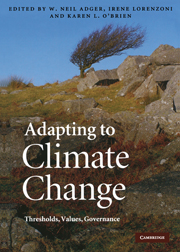Book contents
- Frontmatter
- Contents
- List of contributors
- Preface
- 1 Adaptation now
- Part I Adapting to thresholds in physical and ecological systems
- 2 Ecological limits of adaptation to climate change
- 3 Adapting to the effects of climate change on water supply reliability
- 4 Protecting London from tidal flooding: limits to engineering adaptation
- 5 Climate prediction: a limit to adaptation?
- 6 Learning to crawl: how to use seasonal climate forecasts to build adaptive capacity
- 7 Norse Greenland settlement and limits to adaptation
- 8 Sea ice change in Arctic Canada: are there limits to Inuit adaptation?
- Part II The role of values and culture in adaptation
- Part III Governance, knowledge and technologies for adaptation
- 31 Conclusions: Transforming the world
- Index
- References
4 - Protecting London from tidal flooding: limits to engineering adaptation
Published online by Cambridge University Press: 31 August 2009
- Frontmatter
- Contents
- List of contributors
- Preface
- 1 Adaptation now
- Part I Adapting to thresholds in physical and ecological systems
- 2 Ecological limits of adaptation to climate change
- 3 Adapting to the effects of climate change on water supply reliability
- 4 Protecting London from tidal flooding: limits to engineering adaptation
- 5 Climate prediction: a limit to adaptation?
- 6 Learning to crawl: how to use seasonal climate forecasts to build adaptive capacity
- 7 Norse Greenland settlement and limits to adaptation
- 8 Sea ice change in Arctic Canada: are there limits to Inuit adaptation?
- Part II The role of values and culture in adaptation
- Part III Governance, knowledge and technologies for adaptation
- 31 Conclusions: Transforming the world
- Index
- References
Summary
Introduction
London and the Thames Estuary have one of the best tidal flood defence systems in the world, which offers a standard of protection in excess of a 1 in 1000 year flood (up to at least 2030). However potential drivers such as climate change, socio-economic change and asset deterioration will continue to increase the level of flood risk into the future. Given the long lead times required to implement large- scale infrastructure projects, now is the right time to start planning for the future. Thames Estuary 2100 (TE2100) is an initiative by Anglian, Southern and Thames Regions of the Environment Agency (2008) to develop a plan for flood risk management in the estuary for the next 100 years. The development of this plan is based on a phased programme of study and consultation. This chapter describes one particular work element of TE2100, entitled ‘Limits to adaptation’ (Halcrow for the Environment Agency, 2006).
The ‘Limits to adaptation’ study was initiated by the TE2100 team to gain an early appreciation of the likely limits of large- scale ‘hard engineering-biased’ flood risk management options against incremental sea level rise and different magnitudes of storm surge event in the future. The study has provided TE2100 with a rich insight into the hydraulic performance and possible design considerations of ‘hard’ engineering biased options, such as an outer estuary barrage, in order to aid in the development of different sets of options.
- Type
- Chapter
- Information
- Adapting to Climate ChangeThresholds, Values, Governance, pp. 54 - 63Publisher: Cambridge University PressPrint publication year: 2009
References
- 6
- Cited by



